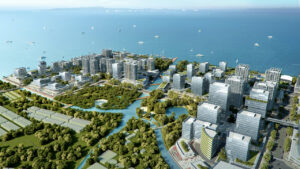No one can do it alone

Last Tuesday, Dec. 7, we held a hybrid launch in Singapore of the over 800 pages of texts, tables, and charts on the Asian Financial Crisis (AFC) and on to the Global Financial Crisis (GFC), organized into a book called Trauma to Triumph: Rising from the Ashes of the Asian Financial Crisis. Under the auspices of the ASEAN+3 Monitoring and Research Office (AMRO), we edited this book with AMRO Chief Economist Hoe Ee Khor and University of Tokyo Professor Emeritus Masahiro Kawai.
It was hybrid event as the turnover of the book was live streamed throughout the world. In-person attendees included the diplomatic corps in Singapore, and officials from both the Singapore Ministry of Finance and Monetary Authority of Singapore, and other various agencies and thought leaders.
The launch coincided with AMRO’s 10th anniversary, with Singapore’s Second Minister for Finance and National Development Indranee Rajah as keynote speaker and guest of honor. She was also presented a hard copy of the book by AMRO’s senior management, led by Toshinori Doi, AMRO’s director.
This book is the first of its kind, a compendium of the most interesting recollections of several major players during the AFC and the GFC, particularly the drama behind those IMF adjustment programs that proved more destabilizing in Thailand, Indonesia, and Korea. Country-level narratives, very nuanced, trace the roots of the crisis and the policy measures to manage it. With the shock of both regional and global proportion, it was made clear that working together is the best approach to contend with future crises.
What is unique about the AFC is that it did not spare even those markets which appeared to have sound macroeconomic fundamentals. Ascribed to volatile capital flows due to financial globalization; expanding but shaky balance sheets and governance of the corporate sector; and inadequately regulated financial sectors across the region, the AFC also devastated the more open capital accounts in various countries in the region. Excessive in-flows of foreign capital triggered financial imbalances, namely credit boom, asset bubble and maturity mismatches.
The GFC, on the other hand, was a shock considered external to the region, and less excruciating to the ASEAN+3 economies. Part of the reason is that the region learned well from the AFC’s key lessons 10 years earlier. Painstaking implementation of policy and structural reforms strengthened the region’s economic fundamentals, improved the health of their financial sector, and broadened their linkages. Another rude wake up call, the GFC actually motivated policymakers to further enhance international and regional cooperation, particularly through the Chiang Mai Initiative Multilateralization (CMIM) that helped birth the AMRO.
This book is also distinguished by the stories of key players during the crises. No less than unique to this book, the stories provide the human interest in the otherwise serious economic fallout from the two crises. For instance, the Fund’s Hubert Neiss recalled that Thailand was the only country where he and his colleagues saw difficulties emerging at an early stage. He said he used to report on Thailand in many Executive Board meetings of the Fund. But Anoop Singh, also of the Fund, admitted that “it took us time to understand that this was not a normal crisis. It was a financial crisis which we were late in recognizing.” Thailand was unfortunate to have experienced this crisis because the Fund itself “underestimated the magnitude of the financial crisis that was coming.”
The most pathetic result of the Thai crisis was high public disaffection with the Bank of Thailand (BoT). Former Governor Chatumongol recalled that “taxis wouldn’t take passengers to the central bank. People who wanted to go to the central bank by taxi had to get off some distance and walk to the BoT because the taxi drivers were so mad at the central bank.”
In Indonesia, people refused to believe the Thai problems would spill over. Its economy experienced an average of 8% growth in the eight years prior to the crisis. Its public finance was robust. Public debt was low relative to total output. The economy was managed by “among the best set of economists I’ve worked with anywhere in the world,” according to the World Bank’s Dennis de Tray.
The other interviewees admitted that financial data were not exactly reliable. Jim Walker of Credit Lyonnais Securities (Asia) Ltd. admitted he never saw the crisis coming because the debt obligations “never really got re-ported in the official statistics for whatever reason.”
The frank assessment of the other member countries based on the personal interviews with their own respective policymakers and thought leaders makes this book different. It concludes with an overall assessment of the crisis and the dynamics of regional financial cooperation in Asia.
Which brings us to the first panel held immediately after the book launch.
Moderated by AMRO’s Dr. Khor, we joined Indonesia’s Former Governor J. Soedradjad Djiwandono, BoT’s Former Deputy Governor Bandid Nijathaworn, and Dr Kawai. Historian and Former MAS Economics Director Freddy Orchard provided an excellent overview of his interviews with key players during the two crises.
After asking each one of us about our respective experiences with crisis management, Dr. Khor asked our opinion on whether the AFC was a blessing in disguise. Dr. Bandid and myself shared a common feeling that indeed it was. We stressed that the AFC made us realize that we had not done enough, and that many more challenges awaited us in making the economy more resilient. For the Philippines, it was relatively easier securing ownership of various policy reforms because no one wanted another crisis. As a result, over the years, we have seen our growth potential expanding, leading to higher employment, public spending for public services and infrastructure, and poverty reduction. We could only admit that we had very limited control of all factors driving the crisis.
Asserting that we could have preempted the crisis would make one guilty of the illusion of control. At the time of AFC, many economies did not even have a semblance of a systematic ledger of external debts by their own governments and much less, their private corporates. With capital flow dynamics driving the AFC on account of weakening market confidence and herding behavior, specific country moves were rather of limited efficacy be-cause like today’s virus, the AFC had several manifestations. In some countries, their overvalued exchange rates gave way to significant adjustments. Those with shaky banking system were undermined by a credit crunch. Overexposed to the debt markets, both domestic and external, some economies experienced further stress from high interest rates and large devaluation.
Radical uncertainty was most pronounced during the AFC. Holding hands together in overcoming future crises should be the way to go.
The ASEAN+3 book therefore echoes what many thought were the logical offshoots of the AFC including former general manager of the Bank for International Settlements (BIS), the late Andrew Crockett, who highlighted the importance of policy coordination. He did not refer to a formalized coordination of national economic policies which did not work in the past. Rather, it is getting the individual countries in the region to pursue “responsible, open and transparent policies, and to allow their exchange rates to move in a way that promotes the international adjustment process.” This approach is expected to gain more traction if mutual consistency of policy actions can be supported by regular exchange of information in international bodies like the IMF and the BIS, and in regional bodies like the AMRO and the ADB.
The book could not be more recent and relevant. In its concluding section, the book called for mitigating the health pandemic by stepping up regional financial cooperation and making the regional economies more re-silient to the viral challenge. AMRO will have to stretch its flexibility in terms of extending longer maturity liquidity support, strengthening the operational readiness of the CMIM through enhanced surveillance, and de-velop more complementarities with the Fund.
Post-pandemic recovery is the next challenge for the region. A multilateral approach remains relevant. No one can do it alone. n
DIWA C. GUINIGUNDO is the former deputy governor for the Monetary and Economics Sector, the Bangko Sentral ng Pilipinas (BSP). He served the BSP for 41 years. In 2001-2003, he was alternate executive director at the International Monetary Fund in Washington, DC. He is the senior pastor of the Fullness of Christ International Ministries in Mandaluyong.




